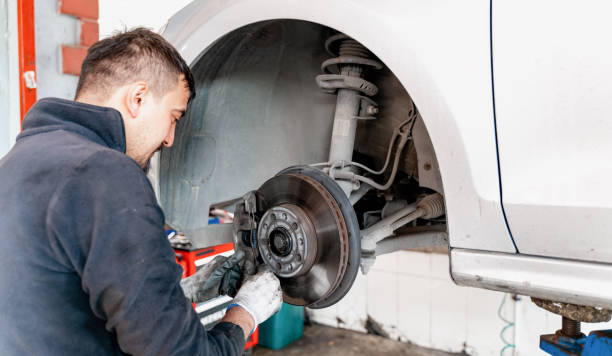The term “disc brake” describes the brake type that uses two pads for brake press on the disc rotor attached to the wheel to stop a vehicle from moving. Four-wheelers or bicycles have disc brakes either on the front or rear wheels. If you’re curious about the meaning of disc brake, then let’s explore disc brakes and how they function.
What Is a Disc Brake?
“disc brake” refers to the kind of brake that uses calipers to push the pads against the disc or “rotor” to generate friction. This, in turn, reduces the speed of rotation of the shaft or reduces the velocity or stopping altogether. This name comes because of the disc-shaped shape of the rotor that disc brake components are mounted.
In the case of the traditional disc brake system, it includes a brake disc, a brake caliper, and two brake pads. When your car moves, the friction pads will be fixed to the disc’s exterior and put on brakes. Let’s take a look at how the disc brake operates.
How Does a Disc Brake Work?
Before we know the mechanism behind disc brakes, let’s briefly review the three significant components of disc brakes. They’re:
Brake pads or friction pads.
A calliperCaliper that includes an engine.
Rotor, which is attached to the hub.
Here are some tips that will help explain the functioning disc brakes’ operation:
When you press a brake pedal, the high-pressure fluid from the master cylinder pushes the piston forward.
The piston allows brake or friction pads to be pressed against the spinning disc.
When the brake pad’s internals are in contact with the brake rotor, enormous brake fluid pressure puts pressure on the caliper.
Then, the caliper moves inside and can pull down the friction pad until it can contact the moving disc.
If both pads apply pressure on the disc, they create massive friction between the place and the disc. This friction decreases the speed of the vehicle and allows it to stop.
When you let off the brake and release it, the piston will return to its original position, causing the brake pad to shift away from the rotating disc. This is how your vehicle will begin to move again.
What Are the Types of Disc Brakes?
If you’ve found the answer to what disc brake, Let’s learn more about its different kinds. Three kinds of disc brake systems are available. These are:
Wave Disc Brake Systems
Another term for disc brakes made of waves is the petal disc brake system. In this kind of system for brakes, the exterior boundaries of the rotor are cut in a curved way. This is done to ensure that it will provide more space where brake pads can grasp the disc as it rotates.
Additionally, due to its wavy shape, that prevents the rotor from overheating. Furthermore, the disc is sought-after because it is lightweight and long-lasting, allowing the highest acceleration.
Cross-Drilled Disc Brake System
The disc brake system that is cross-drilled is a prevalent kind of disc brake for quite an extended period. It was introduced first on race cars in 1960.
These discs feature cross-drilled holes, allowing them to reduce the heat generated during braking and reduce the vehicle’s speed. Drilled rotors will be the best option if you reside in an area prone to rain and mud.
Although the disc brake system with cross-drilled holes can have some advantages However, there are some instances where the disc’s rotating surface becomes damaged or even cracked. It is likely because the cross-drilled holes can make the disc’s surface uneven.
Cross-Slotted Disc Brake System
The cross-slotted disc brake features several slots that cut into the disc’s surface. The design of these slots is unique since their creation differs between different models. This is why these slots may have different widths and different angles.
Automobile manufactures famous cruisers like Harley Davidson, Royal Enfield, Bajaj, etc. Make use of these disc brake systems. In addition, the cross-slotted disc brake systems can disperse more heat as they are more efficient and robust than disc brakes with cross-drilled holes.
What Is the Construction and Mechanism of a Disc Brake?
In a disc-braking system, pressing the brake pedal generates the braking force. This force, in turn, will be absorbed by the channel of brakes until it reaches the disc brake rotor through springs, fulcrums or cylindrical rods, and so on.
The disc or rotor spins in tandem with the wheel. Brake or friction pads prevent them from being attached to the caliper on both sides and can receive pressure from the piston when you push the brake. So, when you press the brake, the piston slows the disc’s movement, reducing your vehicle’s speed or stopping the car.
What are the Benefits and Disadvantages of a disc Brake?
The advantages and disadvantages of disc brakes are as the following:
Advantages
Better cooling brake system for the cooling system.
Generates less heat.
Brake force is guaranteed to remain in place even after contact with water.
The disc brake can deliver massive torque at a low amount.
Disadvantages
The disc brakes of discs cannot support heavy loads.
Wheel rims become dirty, too, in the beginning.
The disc brakes are heavy since numerous components are utilized in their manufacturing
It needs to be maintained frequently.
Typically, it is a little higher priced.
Now that you better understand what a disc brake is, you can add it to your vehicle. To do that, you’ll need to know about its different characteristics, drawbacks, and advantages before you make a final choice.


